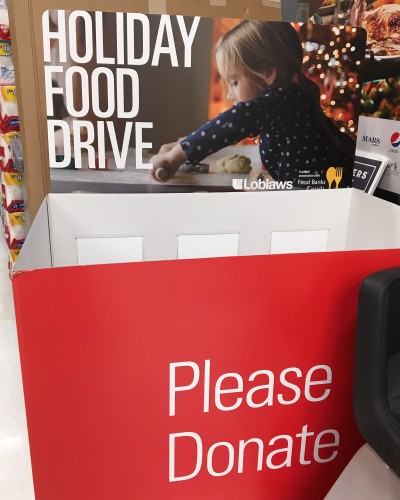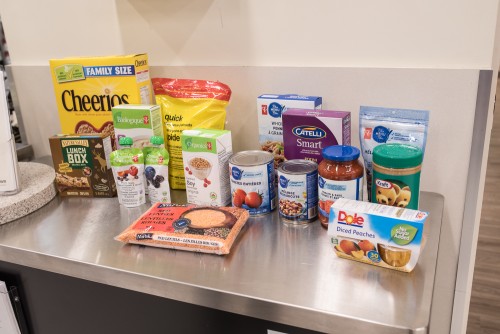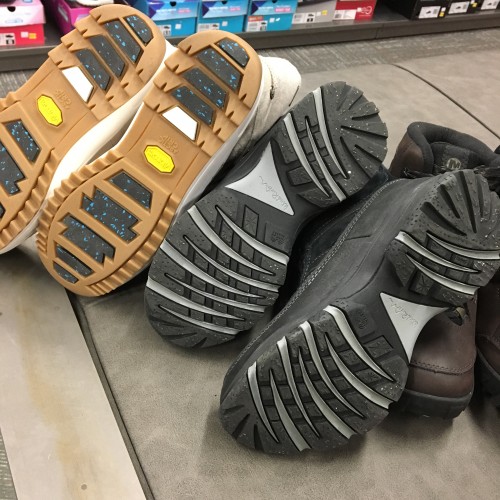I was standing in the cereal aisle at Loblaws, having a conversation with their in-house dietitian about making thoughtful, nutritious donations to local food banks during the holidays. We were comparing the sugar and fibre content of various cereals, when she looked at a box that was higher in sugar and lower in fibre than the thresholds she’d recommended and said, “If it’s a choice between a child eating a bowl of this or going to school with an empty stomach, this is still by far the better choice.â€
My own stomach clenched at the very idea of one of my boys – of any child — spending the whole day at school with an empty stomach simply because there was no food in the cupboard to feed them. I felt tears prick my eyes and very nearly swept the whole shelf into a donation bin. How is it that we have so much and that there are families in our community who don’t have enough food to get them through the day?
Did you know that for more than 850,000 Canadians, one-third of whom are children, the holiday menu will be determined by what’s available in the local food bank? If you’re a long-time reader, you know that for the last few years I have been on a nutritional learning curve of my own, learning to cook from scratch and make smarter food choices for myself and my family. I have to admit, though, that I never put much thought specifically into the nutritional content of the food we donate to the canned food drive or the various food hampers put together in our communities. I was intrigued when Loblaw reached out to me to collaborate on a blog post about the importance of choosing nutritious foods and ingredients to donate to local food drives instead of just emptying the cupboards of whatever your family hasn’t eaten. Loblaw grocery stores have been active in promoting and supporting local food drives this holiday season, and have set a goal to raise $1.8 million and 1.3 million pounds of food for Canadians.

To be honest, I didn’t even know Loblaws offered an in-store Registered Dietitian program before they reached out through this promotion. You can get personalized advice, attend a group session or register for a class in many Loblaws stores across Canada. I went to the Robertson Road Loblaws to speak with Chantal, a dietitian who covers several local stores. We did a little store tour and she gave me insight on making smarter donations to local food drives. Although every donation is welcome, here are some ways to make donations that are healthier and more nutritious:
- Choose canned protein sources that are packed in water instead of oil
- Pick low-sodium or no-salt-added food products
- Consider donating ingredients instead of processed food products (e.g. flour, sugar, spices, nuts and seeds, oils, etc.)
- For added fibre, donate brown rice instead of white rice
- Choose whole-grain food products like cereals, crackers and pasta instead of ones made with white flour
- Granola bars and cereals should contain less than eight grams of sugar and more than five grams of fibre
(Bonus: not only are these good tips for making healthier food drive donations, they’re good rules of thumb to follow for your own family’s nutrition, too! I learned other great tips from her as well. Did you know that longer-grain rice has a lower glycemic index, meaning that it is digested more slowly and makes you feel full longer? And that while green lentils tend to hold their shape when you cook them, red lentils turn mushy and virtually disappear, so they’re a good way to hide a little extra fibre in your soups?)
I’m a big fan of peanut butter donations. Whenever peanut butter goes on sale, I pick up a few for us and a few extra and drop them in the donation bin. One thing I hadn’t really thought of is that the food banks also serve people with special dietary needs like diabetes, gluten sensitivities and high blood pressure, so donating products specifically for people with dietary restrictions is a great choice. Meal supplements for seniors (like Ensure) are welcome donations. Donating dried beans and legumes or shelf-stable nut milks could be beneficial for vegans and vegetarians. And anything for babies (diapers, wipes, formula, iron-fortified cereals and other baby foods) would help young families in need.

Chantal was full of terrific suggestions for smart food donations beyond peanut butter and processed box foods. She gave me a list of a dozen most-needed food items:
- baby food and formula
- no-salt-added canned fish and meat (e.g. salmon, tuna and chicken)
- no-salt-added canned vegetables
- no-sugar-added canned fruit
- whole-grain cereals
- whole wheat pasta
- low-sodium pasta sauce
- legumes (both canned – watch for no-salt-added – and dried beans, lentils and chick peas)
- peanut butter
- rice and whole grain products
- snack foods such as granola bars (watch for less than 8g of sugar and more than 4g of fibre), apple sauce, unsalted nuts and seeds, and dried fruit
- soup broth
Loblaws also has a “guiding stars” program, where foods with more stars point you toward nutritious foods that contain vitamins, minerals, fibre, omega-3 and whole grains versus saturated fat, trans fat, added sodium and added sugar. The more nutritional value a food has, the more stars it receives, so you can look for the two- and three-star foods to help you make nutrition-conscientious food drive donations.
While food donations are always welcome, many food banks such as the Ottawa Food Bank are able to make cash donations stretch much further by buying in bulk. Cash donations also allow food banks to invest in perishable items like fresh fruit and vegetables.
Each year, my teenagers’ school hosts a canned food drive where they collect tonnes of food for donation to smaller food banks such as the Shepherds of Good Hope. I’ll be more conscientious next year when making my donations, and resist the urge to simply reach into the back of the cupboard for the food we haven’t gotten around to eating. In fact, Loblaws has provided compensation for this blog post, and I want to use part of that to take the boys on a dedicated trip to do some shopping specifically for our local food bank via the bin at the Loblaws here in Manotick. I have some great ideas on which foods I want to pick up! I can talk to the boys about the importance of giving AND squeeze in a lesson about healthy food choices, too. That’s a win-win!
Disclosure: I was compensated for my time in researching and writing this blog post. However, as always, all opinions are my own.






